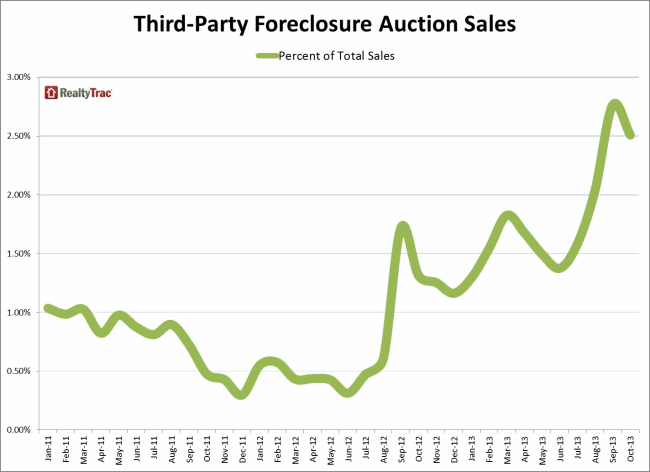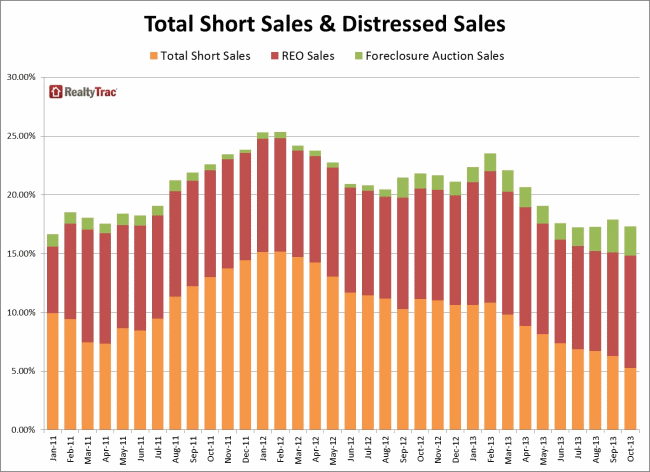RealtyTrac reports that the nature of distressed property sales is evolving. In its most recent report on market and distressed sales, the company noted that changing economics are increasing the reliance on more traditional third party purchases at foreclosure auctions rather than the lender/borrower negotiated sale at less than the outstanding loan balance.
RealtyTrac has adopted a new methodology for accounting for short sales with the distressed and market rate sales report released Monday. The company now applies a calculation to take into account the true loan balance secured by a home at the time of the sale, and additionally separating out of the short sale classification properties that sell at a public foreclosure auction short of the loan balance. It is also including a new category of distressed sale in the report: third-party foreclosure auction sales, which represent sales at the public foreclosure auction to third parties other than the foreclosing lender.
Sales in the new category of auction sales to a third party represented 2.5 percent of sales compared to 2.8 percent in September and nearly twice the 1.3 percent share a year earlier. Significant numbers of these auction sales occurred in Orlando and Jacksonville, Florida, each at 8.6 percent and Columbia, South Carolina at 8.1 percent.

"After a surge in short sales in late 2011 and early 2012, the favored disposition method for distressed properties is shifting back toward the more traditional foreclosure auction sales and bank-owned sales," said Daren Blomquist, vice president at RealtyTrac. "The combination of rapidly rising home prices - along with strong demand from institutional investors and other cash buyers able to buy at the public foreclosure auction or an as-is REO home - means short sales are becoming less favorable for lenders."
Short sales fell from 6.3 percent of sales in September and 11.2 percent in October 2012 to a 5.3 percent share of all sales in October 2013. States with the highest percentage of short sales in October included Nevada (14.2 percent), Florida (13.6 percent), Maryland (8.2 percent), Michigan (6.7 percent), and Illinois (6.2 percent).

REO Sales made up 9.6 percent of the total, up from 8.9 percent in September and 9.4 percent in October 2012. Nearly a quarter of all sales were from REO inventories in Stockton, California (24.4 percent), Las Vegas (23.8 percent), and Cleveland (22.3 percent).
Looking at total sales volume, RealtyTrac reports that residential properties including single family houses, condominiums, and townhouses sold at a slightly higher rate in October than in September. If annualized, homes sold during the month at a rate of 5,649,965 units, an increase of 1 percent from the previous month and 13 percent above the rate in October 2012.
Sales in three of the states which had shown the strongest recovery from the housing crisis fell from a year earlier. California sales were down 15 percent, Arizona 13 percent, and Nevada 5 percent RealtyTrac said.
Prices leveled off during the month remaining at the same $170,000 median level for both market rate and distressed properties as in September. The gap between the two categories of properties remains a substantial 41 percent, $185,000 for a non-distressed property and $110,000 for a bank owned property or a short sale. The median October price for all properties was 6 percent higher than one year earlier and represented the 18th consecutive month in which national prices had increased on an annual basis.
Cash sales represented 44.2 percent of all residential sales in October, down from a revised 45.0 percent in September but up from 33.9 percent in October 2012. Cash sales were a huge part of the total in Florida (65.6 percent), Nevada (55.5 percent), Georgia (55.4 percent), South Carolina (53.9 percent), North Carolina (49.9 percent), Michigan (49.5 percent) and Ohio (49.2 percent).
Institutional investor purchases represented 6.8 percent of all sales in October, a sharp drop from a revised 12.1 percent in September and down from 9.7 percent a year ago but remained a strong factor in Memphis (25.4 percent), Atlanta (23.0 percent), Jacksonville, Fla., (22.2 percent), Charlotte (14.5 percent), and Milwaukee (12.0 percent).







